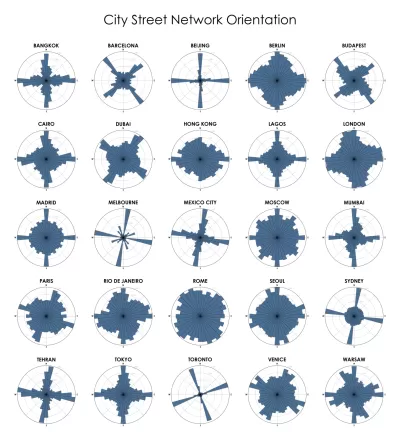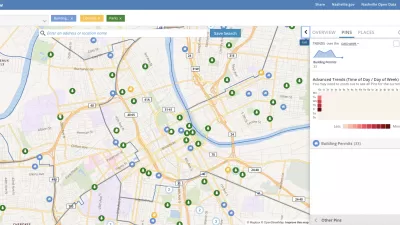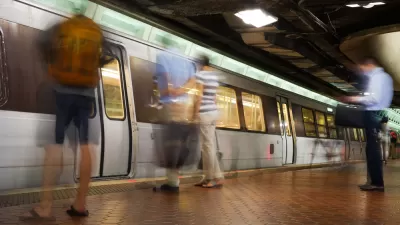The roads in your city might conform to a grid, or they might divert around natural resources or landmarks. A new tool aims to help you visualize the "hidden logic" behind urban growth.

"It works by using an old geography technique: the 'polar' or circular chart. Boeing's tool calculates what percentage of a city's roads run along each section of a compass, and plots it on a circular bar chart."
Because the majority of streets in Manhattan, for example, align along a grid, its network is primarily encompassed in four long bars radiating out from the center of the circle. A few shorter bars represent the smaller portion of streets that don't line up.
Montgomery notes that a similar concept was created recently by data scientist Seth Kadish, but Boeing's adaptation made the model usable by anyone with knowledge of the programming language Python. Developer Vladimir Agafonkin built on Boeing's work to build a version for web browsers, so that "anyone can use a typical web mapping interface to visit any city or other region in the world and see a polar chart of its street grid."
"'It's a wonderful way to explore how cities are built; understand their hidden patterns and influences,' said Agafonkin. 'You can see where a road network was meticulously planned and where it grew naturally. [You can] see subtle connections like terrain, water bodies and nearby attractions influencing the direction of roads.'"
FULL STORY: Visualizing the Hidden ‘Logic’ of Cities

Maui's Vacation Rental Debate Turns Ugly
Verbal attacks, misinformation campaigns and fistfights plague a high-stakes debate to convert thousands of vacation rentals into long-term housing.

Planetizen Federal Action Tracker
A weekly monitor of how Trump’s orders and actions are impacting planners and planning in America.

In Urban Planning, AI Prompting Could be the New Design Thinking
Creativity has long been key to great urban design. What if we see AI as our new creative partner?

Portland Raises Parking Fees to Pay for Street Maintenance
The city is struggling to bridge a massive budget gap at the Bureau of Transportation, which largely depleted its reserves during the Civd-19 pandemic.

Spokane Mayor Introduces Housing Reforms Package
Mayor Lisa Brown’s proposals include deferring or waiving some development fees to encourage more affordable housing development.

Houston Mayor Kills Another Bike Lane
The mayor rejected a proposed bike lane in the Montrose district in keeping with his pledge to maintain car lanes.
Urban Design for Planners 1: Software Tools
This six-course series explores essential urban design concepts using open source software and equips planners with the tools they need to participate fully in the urban design process.
Planning for Universal Design
Learn the tools for implementing Universal Design in planning regulations.
Gallatin County Department of Planning & Community Development
Heyer Gruel & Associates PA
JM Goldson LLC
City of Camden Redevelopment Agency
City of Astoria
Transportation Research & Education Center (TREC) at Portland State University
Jefferson Parish Government
Camden Redevelopment Agency
City of Claremont





























